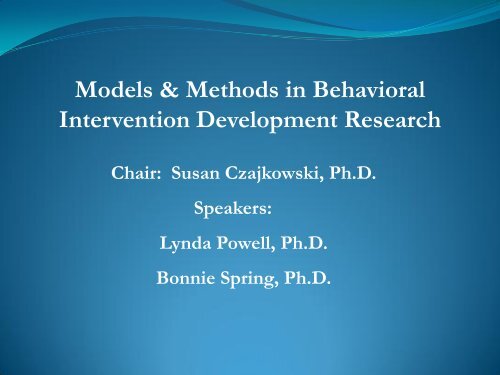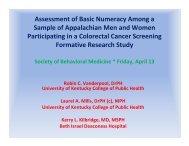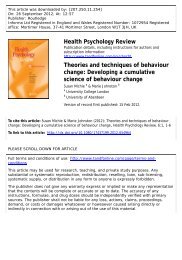Models & Methods in Behavioral Intervention Development Research
Models & Methods in Behavioral Intervention Development Research
Models & Methods in Behavioral Intervention Development Research
Create successful ePaper yourself
Turn your PDF publications into a flip-book with our unique Google optimized e-Paper software.
<strong>Models</strong> & <strong>Methods</strong> <strong>in</strong> <strong>Behavioral</strong><br />
<strong>Intervention</strong> <strong>Development</strong> <strong>Research</strong><br />
Chair: Susan Czajkowski, Ph.D.<br />
Speakers:<br />
Lynda Powell, Ph.D.<br />
Bonnie Spr<strong>in</strong>g, Ph.D.
Chang<strong>in</strong>g unhealthy behaviors is<br />
the “s<strong>in</strong>gle greatest opportunity to reduce premature deaths…”<br />
Schroeder SA. N Engl J Med 2007;357:1221-1228
When we succeed <strong>in</strong> chang<strong>in</strong>g behavior,<br />
we improve health…<br />
A 7% weight reduction and 2.5 hour per week activity <strong>in</strong>crease led to a<br />
58% reduction <strong>in</strong> the cumulative <strong>in</strong>cidence of Type 2 diabetes <strong>in</strong><br />
<strong>in</strong>sul<strong>in</strong>-resistant <strong>in</strong>dividuals.<br />
DPP <strong>Research</strong> Group, NEJM, 2002
Change from basel<strong>in</strong>e weight, Kg<br />
…but behavior change is hard to achieve & even<br />
harder to ma<strong>in</strong>ta<strong>in</strong><br />
3<br />
2<br />
1<br />
0<br />
-1<br />
-2<br />
-3<br />
-4<br />
-5<br />
0 mo 6 mo 12 mo 18 mo 24 mo 30 mo 36 mo<br />
Control<br />
<strong>Intervention</strong><br />
Trials of Hypertension Prevention II:<br />
Weight loss over 36 months <strong>in</strong> 2382 overweight pre-hypertensives<br />
(Stevens et al. Ann Intern Med, 2001)
The challenge: develop<strong>in</strong>g more effective &<br />
susta<strong>in</strong>able health-related behavioral<br />
<strong>in</strong>terventions<br />
Just as with development of better drugs, devices &<br />
surgical techniques, build<strong>in</strong>g better behavioral<br />
<strong>in</strong>terventions depends on our ability to translate<br />
knowledge about human behavior, ga<strong>in</strong>ed through basic<br />
behavioral & social science research, <strong>in</strong>to more effective<br />
behavioral <strong>in</strong>terventions
Translational <strong>Research</strong><br />
• “The process of apply<strong>in</strong>g ideas, <strong>in</strong>sights, and discoveries generated through basic<br />
scientific <strong>in</strong>quiry to the treatment or prevention of human disease” (Zerhouni, 2003).<br />
• Def<strong>in</strong>es a cont<strong>in</strong>uum of research (“bench” to “bedside” to “public health<br />
application”)<br />
• 2 major types of translational research:<br />
• Translation I: Basic science discoveries are used to develop new<br />
treatments for disease (“bench to bedside”)<br />
• Translation II: <strong>Research</strong> aimed at improv<strong>in</strong>g utilization of proven<br />
therapies <strong>in</strong> cl<strong>in</strong>ical practice & community sett<strong>in</strong>gs (“bedside to public<br />
health”)<br />
• Both types are important to both biomedical & behavioral research<br />
• Often <strong>in</strong>volves <strong>in</strong>terdiscipl<strong>in</strong>ary research teams<br />
• Bi-directional <strong>in</strong> nature<br />
• F<strong>in</strong>d<strong>in</strong>gs from basic science can be translated <strong>in</strong>to public health applications<br />
• Observations <strong>in</strong> cl<strong>in</strong>ical/community sett<strong>in</strong>gs can <strong>in</strong>form earlier stages of research<br />
(basic science)
The standard NIH Translational<br />
<strong>Research</strong> model<br />
T1 Translation<br />
T2 Translation<br />
Bench Bedside Public<br />
Health
BSSR<br />
T1 Translation<br />
<strong>Behavioral</strong><br />
<strong>Intervention</strong><br />
T2 Translation<br />
Public<br />
Health
Our current situation:<br />
Not a cont<strong>in</strong>uum of research lead<strong>in</strong>g to public health impact but<br />
parallel paths lead<strong>in</strong>g to ???<br />
Basic behavioral &<br />
social science research<br />
<strong>Behavioral</strong> & psychosocial<br />
<strong>in</strong>tervention studies<br />
Public health & community<br />
studies
Obesity Related <strong>Behavioral</strong> <strong>Intervention</strong> Trials<br />
(ORBIT) RFA program<br />
■ 7 research centers & a Coord<strong>in</strong>ation Unit<br />
■ Interdiscipl<strong>in</strong>ary project teams of basic and applied<br />
biological, cl<strong>in</strong>ical, behavioral and social scientists<br />
■<br />
■<br />
■<br />
Goals of the ORBIT program:<br />
To translate f<strong>in</strong>d<strong>in</strong>gs from basic research on human behavior to<br />
develop more effective <strong>in</strong>terventions to reduce obesity & improve<br />
obesity-related health behaviors<br />
To promote an <strong>in</strong>tervention development process for the behavioral<br />
sciences that is analogous to Type I translation <strong>in</strong> the biomedical<br />
sciences
Translat<strong>in</strong>g Ideas <strong>in</strong>to <strong>Intervention</strong>s:<br />
The Process of Develop<strong>in</strong>g <strong>Behavioral</strong> <strong>Intervention</strong>s<br />
NIH-sponsored Workshop<br />
December 6-7, 2010<br />
‣What model or framework can we use to guide the behavioral <strong>in</strong>tervention<br />
development process?<br />
‣Which study designs & methods are most appropriate for the<br />
development of behavioral <strong>in</strong>terventions?<br />
‣How do we create environments that foster creativity & encourage the<br />
development of <strong>in</strong>novative behavioral <strong>in</strong>terventions?
“Translat<strong>in</strong>g Ideas <strong>in</strong>to <strong>Intervention</strong>s” Workshop<br />
<strong>Models</strong> of <strong>Behavioral</strong> <strong>Intervention</strong> <strong>Development</strong> Group<br />
Nancy Adler, Ph.D.<br />
Lynda Powell, Ph.D.<br />
Brian Wans<strong>in</strong>k, Ph.D.<br />
June Stevens, Ph.D.<br />
Bonnie Spr<strong>in</strong>g, Ph.D.<br />
Lisa Onken, Ph.D.<br />
Sonia Arteaga, Ph.D.<br />
Patty Mabry, Ph.D.<br />
Sarah Kobr<strong>in</strong>, Ph.D.<br />
Melissa Riddle, Ph.D.<br />
William Riley, Ph.D.<br />
Mary Charlson, M.D.
• To facilitate use of a standardized, widely-accepted approach to design<strong>in</strong>g,<br />
develop<strong>in</strong>g and optimiz<strong>in</strong>g health-related behavioral <strong>in</strong>terventions (as is true for<br />
drug development)<br />
• To encourage the development of behavioral <strong>in</strong>terventions that are wellcharacterized,<br />
appropriately tested & optimized prior to test<strong>in</strong>g <strong>in</strong> Phase III trials<br />
– ultimately lead<strong>in</strong>g to better, more powerful behavioral <strong>in</strong>terventions with<br />
greater potential for public health impact<br />
• To provide guidance to researchers, fund<strong>in</strong>g agencies, & reviewers regard<strong>in</strong>g how<br />
best to develop, test and optimize behavioral <strong>in</strong>terventions<br />
• To highlight the importance of T1 & behavioral development research, lead<strong>in</strong>g to<br />
greater academic recognition of this area, additional fund<strong>in</strong>g & tra<strong>in</strong><strong>in</strong>g<br />
opportunities, and more behavioral researchers pursu<strong>in</strong>g translational and<br />
<strong>in</strong>terventional research
T1 research – biomedical<br />
(drug development) model<br />
Bench<br />
Bedside<br />
Drug <strong>Development</strong><br />
Investigation of<br />
biologic<br />
mechanisms of Phase I Phase II Phase III<br />
underly<strong>in</strong>g disease (safety: (biologic activity: (efficacy &<br />
“dose –f<strong>in</strong>d<strong>in</strong>g”) “dose-response”) effectiveness)<br />
Identification of<br />
biologic targets<br />
for <strong>in</strong>tervention<br />
Feasibility Pilot<br />
Mov<strong>in</strong>g animal f<strong>in</strong>d<strong>in</strong>gs<br />
Studies<br />
to human application
Basic <strong>Behavioral</strong><br />
& Social Sciences<br />
<strong>Research</strong><br />
<strong>Behavioral</strong><br />
<strong>Intervention</strong><br />
<strong>Behavioral</strong> <strong>in</strong>tervention development<br />
Investigation<br />
of biological,<br />
behavioral, social,<br />
&/or env. factors Phase I Phase II Phase III<br />
& their <strong>in</strong>fluence<br />
on behavioral RFs (a) (b) (a) (b) Efficacy &<br />
Def<strong>in</strong>ition Design Proof of Pilots Effectiveness<br />
Identification of<br />
concept<br />
behavioral targets<br />
for <strong>in</strong>tervention Def<strong>in</strong>ition & Design POC & Pilots<br />
Proposed Model of <strong>Behavioral</strong><br />
<strong>Intervention</strong> <strong>Development</strong> Process
Proposed Phases of <strong>Behavioral</strong> <strong>Intervention</strong> <strong>Development</strong><br />
Phase I: Def<strong>in</strong>ition & Design<br />
• Phase I(a) -- Def<strong>in</strong>e the scientific basis for the <strong>in</strong>tervention, its mechanisms<br />
& targets<br />
• Phase I(b) -- Design the <strong>in</strong>tervention and def<strong>in</strong>e its essential features<br />
Phase II: Proof of Concept & Pilot Studies<br />
• Phase II(a) -- Determ<strong>in</strong>e if the <strong>in</strong>tervention can produce cl<strong>in</strong>ically significant<br />
improvement <strong>in</strong> the proposed behavioral risk factor target<br />
• Phase II(b) – Determ<strong>in</strong>e:<br />
• whether the <strong>in</strong>tervention’s effects can be replicated <strong>in</strong> larger samples us<strong>in</strong>g a control<br />
condition<br />
• what is the appropriate control condition & how does it behave<br />
• whether the <strong>in</strong>tervention is feasible & acceptable to the target population<br />
• estimates of acceptability of the trial protocol, the effect size of the treatment relative to<br />
the control on a proposed cl<strong>in</strong>ical endpo<strong>in</strong>t, and screen<strong>in</strong>g to enrollment ratios
Proposed Model of <strong>Behavioral</strong> <strong>Intervention</strong> <strong>Development</strong> Process:<br />
Phase I – Def<strong>in</strong>ition & Design<br />
PHASE<br />
Phase Ia:<br />
Def<strong>in</strong>ition<br />
CENTRAL<br />
GOAL<br />
Provide scientific<br />
basis for<br />
<strong>in</strong>tervention<br />
EXAMPLES OF<br />
QUESTIONS<br />
Important cl<strong>in</strong>ical<br />
question identified?<br />
Relevant basic science<br />
theories & f<strong>in</strong>d<strong>in</strong>gs?<br />
<strong>Intervention</strong> targets?<br />
<strong>Behavioral</strong> / biological<br />
mechanism(s) of<br />
action?<br />
Surrogate endpo<strong>in</strong>ts?<br />
Cl<strong>in</strong>ically significant<br />
cut-po<strong>in</strong>ts?<br />
METHODS<br />
Exist<strong>in</strong>g data:<br />
-- epidemiologic<br />
-- meta-analyses<br />
Basic behavioral<br />
science literature<br />
<strong>Behavioral</strong> event<br />
model<strong>in</strong>g<br />
Observational studies<br />
Experiments<br />
MILESTONE<br />
Formulation of a hypothesis<br />
Creation of <strong>in</strong>tervention content and<br />
targets<br />
Phase Ib:<br />
Design<br />
Design and<br />
Ref<strong>in</strong>e<br />
Basic components?<br />
Dose/duration?<br />
Mode of delivery?<br />
Safety?<br />
Tolerability?<br />
Acceptability?<br />
Culturally appropriate?<br />
Tailor<strong>in</strong>g for<br />
subgroups?<br />
Tailor<strong>in</strong>g based on<br />
treatment response?<br />
Formative qualitative<br />
research:<br />
-focus groups<br />
-<strong>in</strong>terviews<br />
-ethnographic<br />
ABA designs<br />
Time series<br />
Factorial/Fractional<br />
factorial<br />
Adaptive treatment<br />
designs<br />
Systems<br />
science/modell<strong>in</strong>g<br />
Satisfaction that <strong>in</strong>tervention is<br />
optimized and formal test<strong>in</strong>g<br />
should beg<strong>in</strong>
Proposed Model of <strong>Behavioral</strong> <strong>Intervention</strong> <strong>Development</strong> Process:<br />
Phase II – Proof of Concept & Pilot Studies<br />
PHASE CENTRAL GOAL EXAMPLES OF<br />
QUESTIONS<br />
Cl<strong>in</strong>ically<br />
significant signal<br />
Phase IIa:<br />
Proof-of-<br />
Concept<br />
As currently designed,<br />
does this <strong>in</strong>tervention<br />
produce a cl<strong>in</strong>ically<br />
significant signal?<br />
Does it alter:<br />
- surrogate markers?<br />
- <strong>in</strong>tervention targets?<br />
If not, can optimization<br />
produce a stronger<br />
signal?<br />
●<br />
METHODS<br />
Quasi-experimental,<br />
treatment-only<br />
design<br />
ABA design<br />
MILESTONE<br />
Confidence that the <strong>in</strong>tervention<br />
as designed can produce a<br />
cl<strong>in</strong>ically significant signal<br />
Phase IIb:<br />
Pilot<br />
Studies<br />
Cl<strong>in</strong>ically<br />
significant signal<br />
over noise<br />
(control)<br />
Preparation for<br />
Phase III efficacy<br />
Trial<br />
Can cl<strong>in</strong>ically significant<br />
benefit be replicated?<br />
Is there a signal over<br />
noise (control)?<br />
Does the control group<br />
behave well?<br />
Response <strong>in</strong><br />
subgroups?<br />
Estimates needed for<br />
efficacy trial<br />
-- effect size<br />
-- yield<br />
-- acceptability &<br />
feasibility<br />
●<br />
●<br />
●<br />
Randomized design<br />
Adaptive treatment<br />
designs<br />
Qualitative studies of<br />
feasibility/acceptability<br />
Confidence that:<br />
--the <strong>in</strong>tervention can produce<br />
a cl<strong>in</strong>ically significant signal<br />
on a behavioral risk factor<br />
above a control<br />
--the trial protocol is feasible<br />
--the control group is<br />
appropriate
Proposed <strong>Behavioral</strong> <strong>Intervention</strong> <strong>Development</strong><br />
Model: Key Features<br />
Progression from basic to more cl<strong>in</strong>ical/applied stages<br />
Flexibility <strong>in</strong> terms of number & types of studies with<strong>in</strong> phases<br />
Duration of each stage can vary depend<strong>in</strong>g on # and needs of studies<br />
Each phase <strong>in</strong>cludes milestones/criteria for mov<strong>in</strong>g to next phase of the<br />
<strong>in</strong>tervention development process<br />
Flow is bi- not uni-directional -- may need to go back to previous phases<br />
depend<strong>in</strong>g on f<strong>in</strong>d<strong>in</strong>gs at any given stage

















